 Krantiveer
Pt. Shyamaji Krishna Varma (Oct 4,1857-Mar 30, 1930)
Krantiveer
Pt. Shyamaji Krishna Varma (Oct 4,1857-Mar 30, 1930)
Shyamaji
Krishna Varma was a great Arya Samajst, a nationalist,a journalist, a lawyer
and a revolutionary, who fought the British from their own soil. He was
the first Indian Bar-at-law, and a graduate of Balliol College, Oxford
University. He was also a noted scholar in Sanskrit for which he was decorated
with the title of ‘Pandit’ by Kashi pundits’ organization. Greatly influenced
by swami Dayanand Saraswati, he became his ardent devotee, a member and then
the president of Bombay Arya Samaj. An admirer of Dayanand
Saraswati
‘s approach of cultural nationalism, and of Herbert Spencer, Krishna Varma
believed in Spencer's dictum "Resistance to aggression is not simply
justified, but imperative".
On 18th Feb 1906 Shyamji
established “The Indian Home Rule Society”
He established.India House as
a hostel for Indian students based at 65,
Cromwell Avenue, Hughgate in London. India House soon developed as an
organized meeting point for radical nationalists among Indian students in
Britain and one of the most prominent centers for revolutionary Indian
nationalism outside India. Most famous among the members of the
organization were V. D. Savarkar, Madam Kama,Sardar Singh Rana, Madan Lal
Dhingra, Gandhi. India House:
 In
London Shyamji published an anti colonial newspaper The Indian Sociologist. On
account of his political activities, he was forced to leave England. He arrived
in paris in early 1907to continue his work for freedom of India. In the wake of
First World War, he left for Switzerland.
In
London Shyamji published an anti colonial newspaper The Indian Sociologist. On
account of his political activities, he was forced to leave England. He arrived
in paris in early 1907to continue his work for freedom of India. In the wake of
First World War, he left for Switzerland.
Shyamaji Krishna Varma was born on 4th
October, 1857 in Mandvi, a province in Kutch, Gujarat to Karsan Bhanushali,
and Gomati Ba. His mother died when Shyamaji was only eleven years old. Shyamji
Krishna Varma was then raised by his grandmother. He had his primary education
in the village school at Mandvi and thereafter completed his  Secondary
education in Bhuj. He went to Mumbai for further education at Wilson High
School . In Mumbai, he learnt Sanskrit language in great depth from Shashtri
Vishvanath and mastered the language. In 1875 Shyamaji Krishna Varma got
married to Bhanumati, daughter of a wealthy businessman, from the Bhatia
community.
Secondary
education in Bhuj. He went to Mumbai for further education at Wilson High
School . In Mumbai, he learnt Sanskrit language in great depth from Shashtri
Vishvanath and mastered the language. In 1875 Shyamaji Krishna Varma got
married to Bhanumati, daughter of a wealthy businessman, from the Bhatia
community.
|
Inspired
by Rishi Dayanand in 1877, he Toured India to propagate the philosophy
of Vedas and earned the title of “Pandit” from the pundits of Kashi. In
1878 Shyamji Joined
professor Monier Williams as his assistant to help him in translation of
Vedas.
|
|
|
|
|
|
|
In
1879 Shyam ji joined Balliol College, Oxford as assistant professor in
Sanskrit. In 1881 he represented India at the Berlin Congress of Orientalists
and read a paper on "Sanskrit as a Living Language of India"
|
|
|
During 1885 to 1895 Shyam ji Krishna Varma
returned to India and served as Diwan (Principal Secretary) of Ratlam,
practised as a lawyer at Ajmer and also became the Diwan of Ajmer. He was also
appointed as the council member with Maharaja of Udaipur and later he served as
the Diwan of Junagadh State.
Nationalism and Social Reforms
Shyamji Krishna Varma was highly
impressed with Rishi Dayanand brand of nationalism, religious and social
reforms. He fully supported Tilak during the consent of Age Bill Controversy of
1890. Shyamji initiated friendly relations with Tilak, which inspired him to
the Nationalist Movement in the next decade. But soon the timid and futile
cooperative policy of Congress Party did not appeal to Shyamji. He dejected the
petitioning, praying, protesting, cooperating and collaborating policy of the
Congress Party, which he considered undignified and shameful.
In 1897, the atrocities
inflicted during the plague crisis in Poona on Indians by the British
Government, stunned and shocked Shyamji. At this point in life, he felt full
justification for the Nationalist stand taken by Nathu brothers and Tilak. When
he saw them sentenced to a barbarous imprisonment, he imagined his future also ending
up in jail like others. His immediate decision was to give up his lucrative
career and to immigrate to England with a view to carry out the freedom fight
from abroad. Now, he had only one business in mind - training and inspiring the
young sons and daughters of India to strive for the liberty of their
Motherland.
Upon his arrival in
London, he stayed at the Inner Temple and studied Herbert Spencer's writings in
his spare time. In 1900 he bought an expensive house in HighGate. His home
became a base for all political leaders of India. Gandhiji, Lenin, Tilak, Lala
Lajpat Rai, Gopal Krishna Gokhale, and many more visited him to discuss the
Indian Independence Movement. Avoiding the Indian National Congress, he
kept in contact with the rationalists, free thinkers, national and social
democrats, socialists, Irish republicans, etc
He decided to dedicate all his
money, time, scholarship, literary power and above all his life to serve his
Motherland selflessly. He deliberately intended to launch uncompromising
propaganda and to create support in England and Europe for the independence of
India. In 1898, when a free press defence committee was formed in order to
resist police attack upon liberty of all opinions, Shyamji subscribed
generously to its funds.
Shyamji was also a great
admirer of Herbert Spencer's philosophy. Herbert Spencer died 14th December
1903 and in his honor Shyamji established an annual lectureship at Oxford for
the sum of £1000. In addition, he endowed a Swami Dayanand fellowship
and many other fellowships in honor of great Indians.
Life and Work in England
In 1905, Shyamji embarked on
a new career as a full-fledged propagandist to free Mother India. He made his
debut by publishing the first issue of his English monthly "The Indian
Sociologist" - an organ of freedom and of political, social and religious
reform. This powerful ideological monthly served a great purpose in uplifting
the mass against British rule and encouraged many more intellectual
revolutionaries in India and abroad to fight for the freedom of India. On 18th
February 1905, Shyamji inaugurated a new organisation called "The Indian
Home Rule Society". The first meeting for the same was held at Shyamji's
residence at HighGate and the meeting unanimously decided to found "The
Indian Home Rule Society" with the object of:
1. Securing
home rule for India
2. Carrying
on propaganda for support.
In
the wake of World War I, Shyamji had moved his headquarters to Geneva in 1914.
Due to the outbreak of war, Shyamji stopped the publication of "Indian
Sociologist" and resumed publication in 1920. His last two issues of
"Indian Sociologist", as per his wish, were to be taken as his last
will and testament of his work. After several health problems, the great
patriot, Shyamji Krishna Varma, passed away on 30th March 1930 far away from
his beloved Motherland India.
News
of his death was suppressed by the British government in India. Nevertheless
tributes were paid to him by Sardar Bhagat Singh and his co-revolutionist
brothers in Lahore Jail where they were undergoing a long-term drawn out trial.
Maratha, a daily newspaper started by Shri Tilak in Marathi, paid very touching
tribute to him as a great revolutionary.
We bow to the memory of such a great visionary,
statesman, scholar, revolutionary who sacrificed all his life, time and money for
mother India.
Commemoration:
Pandit Shyamaji Krishna Varma did not live to witness the independence of
Bharat, but his efforts, conviction and confidence of India gaining its freedom
from British rule in future was strong and unshakable as he made the prepaid
arrangements with the local government of Geneva, Ville de Geneve, and St
Georges cemetery to preserve his and his wife's ashes (Asthis) at the cemetery
for one hundred years and to send their urns to India whenever it becomes
independent during that period.

Shri
Narendra Modi, Chief Minister of Gujarat State, finally succeeded in returning
the urns of Pandit Shyamji and his wife Bhanumati on August 22, 2003 - fifty
five years after Indian Independence.
A
grand memorial, called Kranti Teerth has been built in Kuchh, Gujrat The urns of ashes of Shyamji and
his wife were brought from Geneva, Switzerland to lay at rest in this memorial Kranti Teerth Memorial
Kranti Teerth Memorial
Kranti Teerth
Memorial For Pt shyam ji Krishna Verma is located near Lohana
Mahajan Wadi. The Smarak of Shyamji Krishna Varma was newly build
just 3 km away from Mandvi on Mandvi-Dhrabudi Road The
Memorial’s objective is to pay tribute to the contribution of Shyamji Krishna
Varma and also to educate the young generation about those great Indians who
sacrificed everything for the country’s freedom
 The
Indian Sociologist of September, 1908, London
The
Indian Sociologist of September, 1908, London
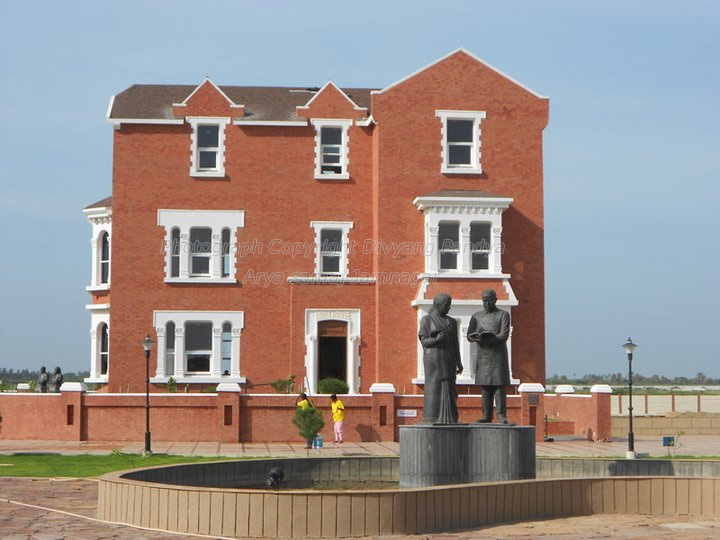
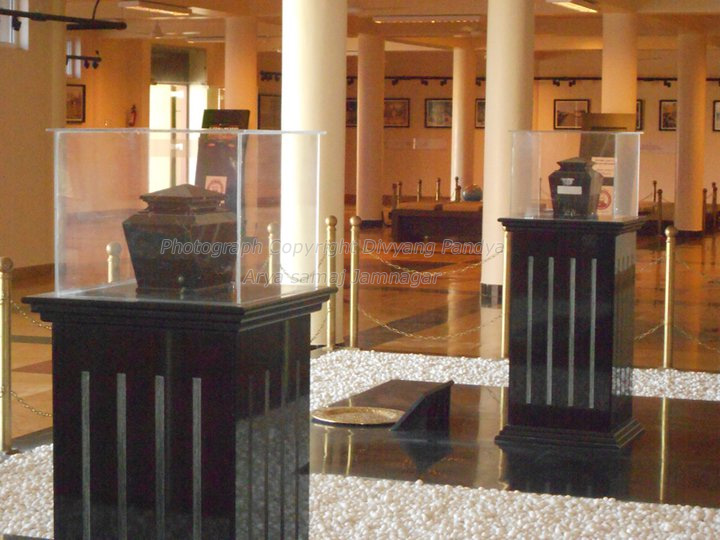
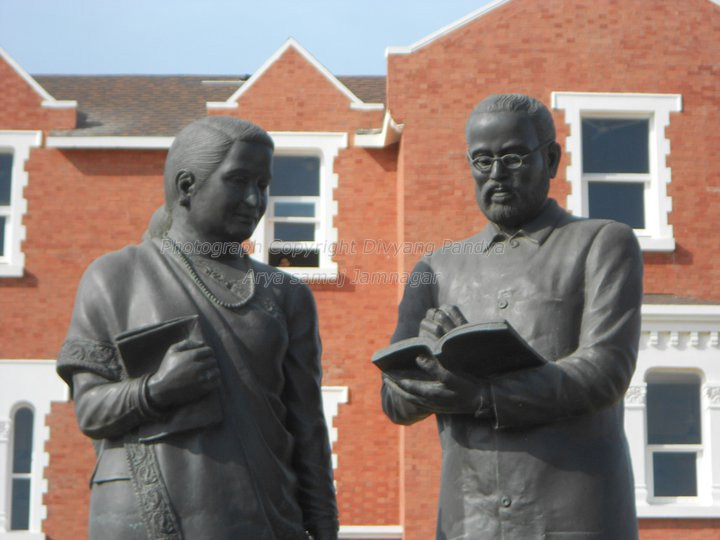
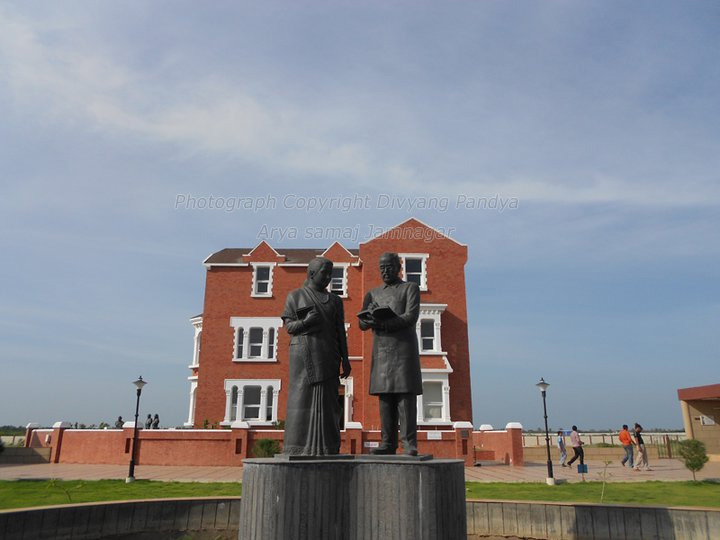
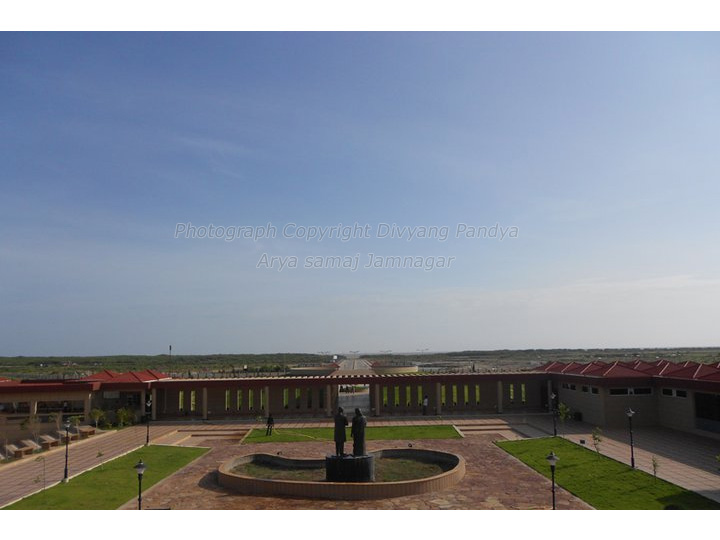
The
memorial The memorial has a replica of the famous India House, a library and a
research centre to study the contributions of Shyamji Varma and other great
revolutionaries to the country's freedom movement. Moreover, it also has on
display paintings of the famous Indian revolutionaries which have been painted
by some of the renowned artists.

Shyamji
Krishna Varma Smriti Kaksha
|
The urns containing
the ashes of the great freedom fighter Shyamji Krishna Varma and his
wife Bhanumati Krishnavarma are kept in the Smriti Kaksh of the
Memorial. This gallery pays homage to the memory of one of India s
foremost nationalists and to his wife who was his strongest supporter
and constant companion.
Excerpts of The Indian Sociologist, his publication which was an organ
of freedom and of political, social and religious reform, are also
displayed.,
|
|
|
Dayananda Saraswati Chowk
at the memorial: The memorial has a gallery that is dedicated to Swami Dayanand Saraswati. Swami
ji’s work and birth place - Tankara , Gujarat are displayed. Swami Dayanand
greatly inspired Krantiveer Shyamji.

The gallery displays
glimpses of Swami Dayanand Saraswati's, work and birth place - Tankara ,
Gujarat. Swami Dayanand greatly inspired Krantiveer Shyamji.
|

|
|
|
Additionals:
To read more: http://www.krantiteerth.org/about-shyamji-krishna-verma.html
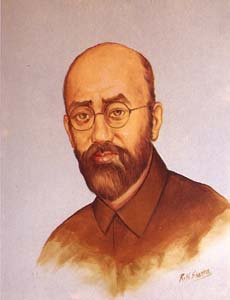
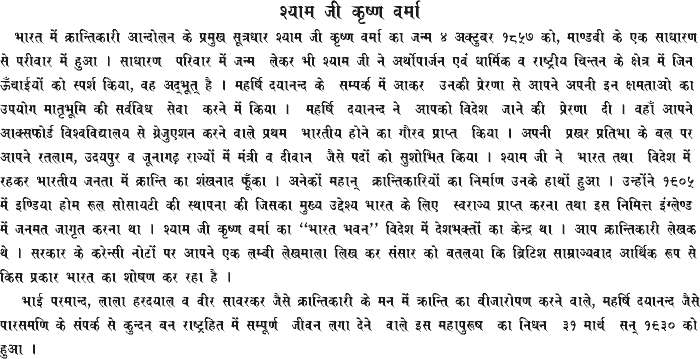


 Secondary
education in Bhuj. He went to Mumbai for further education at Wilson High
School . In Mumbai, he learnt Sanskrit language in great depth from Shashtri
Vishvanath and mastered the language. In 1875 Shyamaji Krishna Varma got
married to Bhanumati, daughter of a wealthy businessman, from the Bhatia
community.
Secondary
education in Bhuj. He went to Mumbai for further education at Wilson High
School . In Mumbai, he learnt Sanskrit language in great depth from Shashtri
Vishvanath and mastered the language. In 1875 Shyamaji Krishna Varma got
married to Bhanumati, daughter of a wealthy businessman, from the Bhatia
community.

 The
Indian Sociologist of September, 1908, London
The
Indian Sociologist of September, 1908, London





